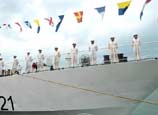
 |
| Qi Zhenxiang, a keeper of the Yongling mausoleums, can watch the site on a computer. Cui Meng / China Daily |
Qi Zhenxiang, a colleague of Li, was on duty sitting in front of a screen.
A single bed lies on the other side of the room, making it a temporary dorm.
"We usually work here and go back to our village to have meal," Li said.
Both Li and Qi live in Yongling village, one named after the mausoleum, which is only 10 minutes' walk away.
"My ancestors came to the village several hundreds years ago during the Qing Dynasty (1644-1911) as tomb keepers," Li said. "I don't know which generation I am."
Like Yongling Mausoleum, every mausoleum of the Royal Mausoleum of Ming is located near a village named after the mausoleum.
According to Hu Hansheng, a researcher in Ming tomb study in the special administration, most of the villagers near the tombs are descendants of keepers assigned during the Qing Dynasty.
Although each village in the area now has hundreds of residents, only a few keepers are needed for each mausoleum, Hu said.
"Most of the villagers are doing other business, often migrating to cities to work, and only these few villagers continue to do the work their ancestors did," he said.
Keepers in the old times were assigned primarily to guard against tomb thieves, as precious treasures were buried under the imperial tombs, Hu said.
"The main purpose of the keepers today is preserving the cultural legacy," he said.
Besides these keepers, armed police forces are also deployed in Changling and Dingling mausoleums, as cultural relics obtained from the tombs have been displayed there, he said.
Liu Yanliang, a tomb keeper of Kangling Mausoleum, said protection of the sites has been intensified, compared to 10 years ago when he started to work there.
"It is much more difficult to access the mausoleum these days, unless you have a special permit from the Ming Tombs Special Administration," he said.
"Only old guys like us are willing to do the job," Liu said. "The young ones could not stay here for long, as they like places with more people."
To avoid loneliness, Liu raised a dog, named "Dahei", meaning big black guy.
"Though Dahei is obedient and cute, I am not satisfied with him," he said.
"I tried to train him like a bodyguard so he could stop bad guys from entering the mausoleum, but I failed. Now he seems to welcome every visitor," he said, laughing.
Although one of his legs was injured in a car accident a few years ago, Liu still keeps walking and checking the whole mausoleum several times every day.
"Everyone knows these royal tombs are a valuable cultural legacy of mankind," he said. "It is our duty to keep them intact.

















 1,000-meter-long Spider Walk of Canton Tower opens
1,000-meter-long Spider Walk of Canton Tower opens


![]()
